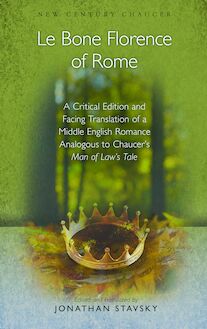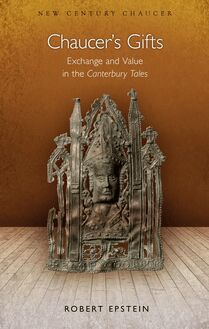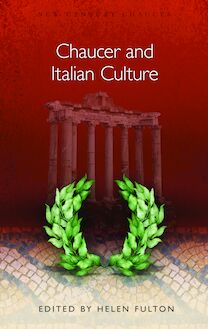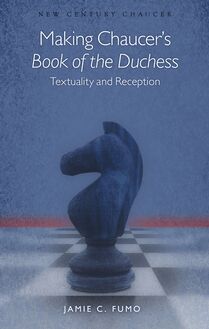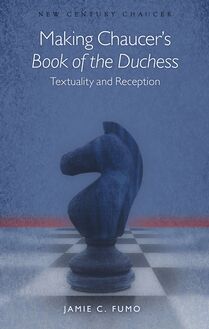-
 Univers
Univers
-
 Ebooks
Ebooks
-
 Livres audio
Livres audio
-
 Presse
Presse
-
 Podcasts
Podcasts
-
 BD
BD
-
 Documents
Documents
-
- Cours
- Révisions
- Ressources pédagogiques
- Sciences de l’éducation
- Manuels scolaires
- Langues
- Travaux de classe
- Annales de BEP
- Etudes supérieures
- Maternelle et primaire
- Fiches de lecture
- Orientation scolaire
- Méthodologie
- Corrigés de devoir
- Annales d’examens et concours
- Annales du bac
- Annales du brevet
- Rapports de stage
La lecture à portée de main
Vous pourrez modifier la taille du texte de cet ouvrage
Découvre YouScribe en t'inscrivant gratuitement
Je m'inscrisDécouvre YouScribe en t'inscrivant gratuitement
Je m'inscrisEn savoir plus
Vous pourrez modifier la taille du texte de cet ouvrage
En savoir plus

Description
Geoffrey Chaucer’s Canterbury Tales, the most celebrated literary work of medieval England, portrays the culture of the late Middle Ages as a deeply commercial environment, replete with commodities and dominated by market relationships. However, the market is not the only mode of exchange in Chaucer’s world or in his poem. Chaucer’s Gifts reveals the gift economy at work in the tales. Applying important recent advances in anthropological gift theory, it illuminates and explains this network of exchanges and obligations. Chaucer’s Gifts argues that the world of the Canterbury Tales harbours deep commitments to reciprocity and obligation which are at odds with a purely commercial culture, and demonstrates how the market and commercial relations are not natural, eternal, or inevitable – an essential lesson if we are to understand Chaucer’s world or our own.
Acknowledgements
Introduction: Chaucer’s Commodities, Chaucer’s Gifts
1 The Franklin’s Potlatch and the Plowman’s Creed: The Gift
in the General Prologue
2 The Lack of Interest in the Shipman’s Tale: Chaucer and
the Social Theory of the Gift
3 Giving Evil: Excess and Equivalence in the Fabliau
4 The Exchange of Women and the Gender of the Gift
5 Sacred Commerce: Clerics, Money and the Economy of
Salvation
6 ‘Fy on a thousand pound!’ Debt and the Possibility
of Generosity in the Franklin’s Tale
Conclusion
Notes
Bibliography
Index
Sujets
Informations
| Publié par | University of Wales Press |
| Date de parution | 01 février 2018 |
| Nombre de lectures | 0 |
| EAN13 | 9781786831712 |
| Langue | English |
Informations légales : prix de location à la page 0,0950€. Cette information est donnée uniquement à titre indicatif conformément à la législation en vigueur.
Extrait
NEW CENTURY CHAUCER
Chaucer’s Gifts
NEW CENTURY CHAUCER
Series Editors Professor Helen Fulton, University of Bristol Professor Ruth Evans, Saint Louis University
Editorial Board Professor Ardis Butterfield, Yale University Dr Orietta Da Rold, University of Cambridge Dr David Matthews, University of Manchester
The works of Geoffrey Chaucer are the most-studied literary texts of the Middle Ages, appearing on school and university syllabuses throughout the world. From The Canterbury Tales through the dream visions and philosophical works to Troilus and Criseyde , the translations and short poems, Chaucer’s writing illuminates the fourteenth century and its intellectual traditions. Taken together with the work of his contemporaries and successors in the fifteenth century, the Chaucerian corpus arguably still defines the shape of late-medieval literature.
For twentieth-century scholars and students, the study of Chaucer and the late Middle Ages largely comprised attention to linguistic history, historicism, close reading, biographical empiricism and traditional editorial practice. While all these approaches retain some validity, the new generations of twenty-first-century students and scholars are conversant with the digital humanities and with emerging critical approaches – the ‘affective turn’, new materialisms, the history of the book, sexuality studies, global literatures, and the ‘cognitive turn’. Importantly, today’s readers have been trained in new methodologies of knowledge retrieval and exchange. In the age of instant information combined with multiple sites of authority, the meaning of the texts of Chaucer and his age has to be constantly renegotiated.
The series New Century Chaucer is a direct response to new ways of reading and analysing medieval texts in the twenty-first century. Purpose-built editions and translations of individual texts, accompanied by stimulating studies introducing the latest research ideas, are directed towards contemporary scholars and students whose training and research interests have been shaped by new media and a broad-based curriculum. Our aim is to publish editions, with translations, of Chaucerian and related texts alongside focused studies which bring new theories and approaches into view, including comparative studies, manuscript production, Chaucer’s post-medieval reception, Chaucer’s contemporaries and successors, and the historical context of late-medieval literary production. Where relevant, online support includes images and bibliographies that can be used for teaching and further research.
The further we move into the digital world, the more important the study of medieval literature becomes as an anchor to previous ways of thinking that paved the way for modernity and are still relevant to post-modernity. As the works of Chaucer, his contemporaries and his immediate successors travel into the twenty-first century, New Century Chaucer will provide, we hope, a pathway towards new interpretations and a spur to new readers.
NEW CENTURY CHAUCER
Chaucer’s Gifts
Exchange and Value in the Canterbury Tales
ROBERT EPSTEIN
© Robert Epstein, 2018
All rights reserved. No part of this book may be reproduced in any material form (including photocopying or storing it in any medium by electronic means and whether or not transiently or incidentally to some other use of this publication) without the written permission of the copyright owner except in accordance with the provisions of the Copyright, Designs and Patents Act 1988. Applications for the copyright owner’s written permission to reproduce any part of this publication should be addressed to the University of Wales Press, 10 Columbus Walk, Brigantine Place, Cardiff CF10 4UP.
www.uwp.co.uk
British Library Cataloguing-in-Publication Data
A catalogue record for this book is available from the British Library.
ISBN 978-1-78683-168-2 (hardback)
978-1-78683-169-9 (paperback)
eISBN 978-1-78683-171-2
The right of Robert Epstein to be identified as author of this work has been asserted in accordance with sections 77, 78 and 79 of the Copyright, Designs and Patents Act 1988.
The publisher has no responsibility for the persistence or accuracy of URLs for any external or third-party internet websites referred to in this book, and does not guarantee that any content on such websites is, or will remain, accurate or appropriate.
Cover image: © Museum of London.
For Marcia Cove Epstein and in memory of Jacob Epstein
CONTENTS
Acknowledgements
Introduction: Chaucer’s Commodities, Chaucer’s Gifts
1 The Franklin’s Potlatch and the Plowman’s Creed: The Gift in the General Prologue
2 The Lack of Interest in the Shipman’s Tale : Chaucer and the Social Theory of the Gift
3 Giving Evil: Excess and Equivalence in the Fabliau
4 The Exchange of Women and the Gender of the Gift
5 Sacred Commerce: Clerics, Money and the Economy of Salvation
6 ‘Fy on a thousand pound!’: Debt and the Possibility of Generosity in the Franklin’s Tale
Conclusion
Notes
Bibliography
ACKNOWLEDGEMENTS
A n advantage of working at a relatively small university is that most of one’s daily interactions are interdisciplinary. Some years ago (more than I care to acknowledge), I was having lunch at the campus cafeteria with David Crawford, an economic anthropologist. Taking a break from the usual faculty pastime of griping about the administration, David asked me what I was working on. I explained that I had been studying the Canterbury Tales through the lens of the social theory of Pierre Bourdieu. David knew Bourdieu’s work well; like Bourdieu, he had done field work on North African Berber communities. I went on to tell him that I was frustrated because I was now trying to analyse the Shipman’s Tale , the Chaucerian tale that I thought should lend itself most readily to Bourdieusian interpretation, but the economics of it – the combination of symbolic and material capital – just didn’t seem to be working out. David said, ‘You should read Graeber.’ That remark led me to David Graeber’s Toward an Anthropological Theory of Value , which then led me on an odyssey into gift theory.
That initial lunch conversation has never ended. This book has been written largely under the tutelage of David Crawford and of our friend and colleague Dennis Keenan of Fairfield University’s Philosophy Department. (David and Dennis team-teach an interdisciplinary course on gift theory.) The experience of tackling this topic has been broadly collegial and interdisciplinary. For some years, I met regularly with an ‘economic anthropology reading group’, including, in addition to Profs Crawford and Keenan, our colleagues Jay Buss (economics), Eric Mielants (sociology) and Steven Batchelor (history). I have also met monthly with a scholarly writing group, founded by Angela Harkins (religious studies) and including at various times Danke Li and Giovanni Ruffini (history), Elizabeth Petrino and Shannon Kelley (English), and Sarah Diaz (Italian studies); without the insight and support of this group, I can’t imagine myself writing a word. I have benefited as well from conversations with colleagues including Marice Rose (art history), Scott Lacy (anthropology), Paul Lakeland, John Thiel, and John Slotemaker (religious studies), Anna Lawrence (history), and Michael Andreychik and Susan Rakowitz (psychology), and with a number of professional anthropologists – Daniel Bass and Hilary Haldane in particular – who have been exceedingly patient with my amateur enthusiasm. I am immeasurably grateful for the generosity of my colleagues in the Fairfield University English Department, especially Peter Bayers, Beth Boquet, Betsy Bowen, Emily Orlando and Nels Pearson.
I sent a large portion of the manuscript of this book to Robert J. Meyer-Lee for his comments. He sent me back the most thorough and extensive reader’s report that I have ever received. I have tried to revise the text in accordance with his insights, but Bobby bears no responsibility for its surviving errors or failings. I owe thanks to Helen Fulton and Ruth Evans, who showed interest in an idiosyncratic book proposal and stuck with it. In the later stages of composition I discovered that Roger Ladd had published an article entitled ‘Gower’s Gifts’; Roger has been generous in offering insights and advice on the topic, and in not objecting to my title. And I am pleased to have an opportunity to thank Derek Pearsall, who attended the panel at Kalamazoo where I first presented the argument on the Shipman’s Tale that had originated at lunch with David Crawford and that was the germ for this project. Derek’s words of support then were a small part of many years of exceptional generosity and wisdom – a gift that I can never repay.
Portions of this book have appeared previously in print. A version of the second chapter was published in Modern Philology , 113 (© 2015, University of Chicago Press). The first half of the fifth chapter, under the title ‘Sacred Commerce: Chaucer, Friars, and the Spirit of Money’, was included in Sacred and Profane in Chaucer and Late Medieval Literature: Essays in Honour of John V. Fleming , edited by William Robins and myself and published in 2010 by the University of Toronto Press. My work on Chaucer’s Gifts has been supported by research grants from Fairfield University.
Finally, thanks to Miriam, Joseph and Nathaniel, who are the greatest gifts of all (not least for their patience when I talk about gifts).
INTRODUCTION:
Chaucer’s Commodities, Chaucer’s Gifts
C haucer’s Canterbury Tales opens onto a world of commodities. Much of the work describes the contemporary commercial world, where commodities are ubiquitous. The Wife of Bath, a manufacturer of fine commercial cloth, makes a show of wearing her own wares, and other expensive clothes:
Hir coverchiefs ful fyne weren of ground;
I dorste swere they weyeden ten pound
That on a Sonday weren upon hir heed.
Hir hosen weren of fyne
-
 Univers
Univers
-
 Ebooks
Ebooks
-
 Livres audio
Livres audio
-
 Presse
Presse
-
 Podcasts
Podcasts
-
 BD
BD
-
 Documents
Documents
-
Jeunesse
-
Littérature
-
Ressources professionnelles
-
Santé et bien-être
-
Savoirs
-
Education
-
Loisirs et hobbies
-
Art, musique et cinéma
-
Actualité et débat de société
-
Jeunesse
-
Littérature
-
Ressources professionnelles
-
Santé et bien-être
-
Savoirs
-
Education
-
Loisirs et hobbies
-
Art, musique et cinéma
-
Actualité et débat de société
-
Actualités
-
Lifestyle
-
Presse jeunesse
-
Presse professionnelle
-
Pratique
-
Presse sportive
-
Presse internationale
-
Culture & Médias
-
Action et Aventures
-
Science-fiction et Fantasy
-
Société
-
Jeunesse
-
Littérature
-
Ressources professionnelles
-
Santé et bien-être
-
Savoirs
-
Education
-
Loisirs et hobbies
-
Art, musique et cinéma
-
Actualité et débat de société
- Cours
- Révisions
- Ressources pédagogiques
- Sciences de l’éducation
- Manuels scolaires
- Langues
- Travaux de classe
- Annales de BEP
- Etudes supérieures
- Maternelle et primaire
- Fiches de lecture
- Orientation scolaire
- Méthodologie
- Corrigés de devoir
- Annales d’examens et concours
- Annales du bac
- Annales du brevet
- Rapports de stage
